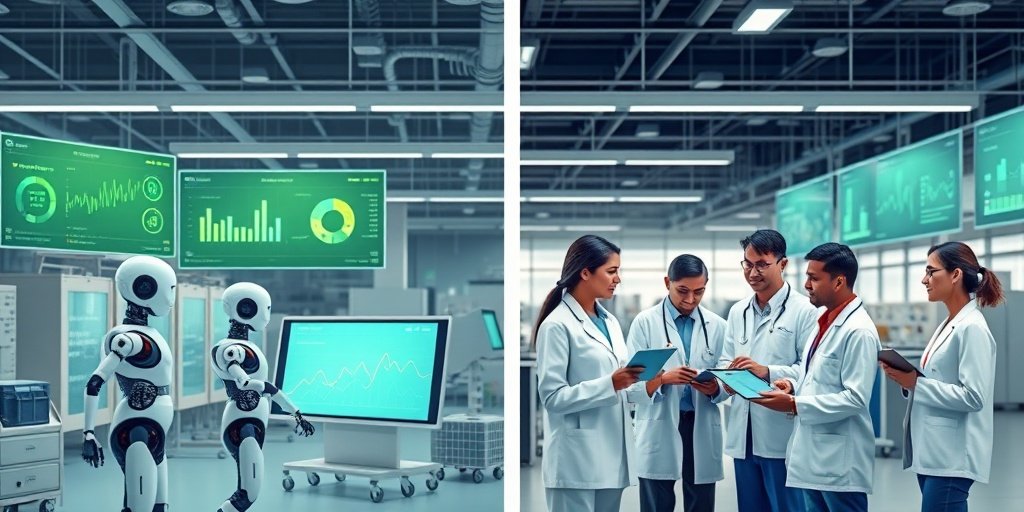⚡ Quick Summary
The article discusses the emergence of Industry 5.0, which aims to leverage Big Data and Artificial Intelligence (AI) while addressing the vulnerabilities of extreme automation. It emphasizes the need for a balanced approach to innovation that includes safety measures and ethical considerations in technology policy.
🔍 Key Details
- 📊 Focus: Industry 5.0 and its implications for Big Data and automation
- 🧩 Technologies: Internet of Things (IoT), AI, and collaborative robots (cobots)
- ⚙️ Key Concepts: Symmetrical innovation and safe exit strategies
- 🏆 Proposed Framework: Post-ELSI Technology Evaluation Research (PETER)
🔑 Key Takeaways
- 🌐 Industry 5.0 aims to democratize knowledge production from Big Data.
- 🔗 Extreme automation poses risks such as systemic vulnerabilities and authoritarian governance.
- 💡 Symmetrical innovation includes a built-in safe exit strategy for digital networks.
- ⚖️ Ethical considerations are crucial in technology policymaking, as highlighted by PETER.
- 📉 Innovation management should balance acceleration and deceleration based on returns.
- 🛡️ Safety measures are essential to mitigate risks associated with hyperconnected systems.
- 📚 Next-generation research in social sciences is vital for global governance of emerging technologies.

📚 Background
The rapid advancement of technology has led to the rise of Industry 4.0, characterized by extreme automation and connectivity through the IoT. However, this has raised concerns about the vulnerabilities inherent in such systems, including potential systemic risks and the emergence of new power structures. The authors propose a new paradigm, Industry 5.0, to address these challenges while harnessing the benefits of automation and Big Data.
🗒️ Study
The article outlines the conceptual framework for Industry 5.0, emphasizing the importance of symmetrical innovation in designing innovation ecosystems. This framework includes strategies for safe exits from hyperconnected networks, ensuring that knowledge production remains accessible and democratic. The authors advocate for a balanced approach to innovation that considers both acceleration and deceleration based on the context.
📈 Results
The proposed framework for Industry 5.0 highlights the need for Post-ELSI Technology Evaluation Research (PETER), which integrates ethical considerations and opportunity costs into technology policymaking. This approach aims to create a more responsible and sustainable implementation of emerging technologies, ensuring that the benefits of automation do not come at the expense of societal well-being.
🌍 Impact and Implications
The implications of Industry 5.0 are profound, as it seeks to harness the power of Big Data and AI while addressing the vulnerabilities of extreme automation. By promoting a more democratic and ethical approach to technology, Industry 5.0 could lead to a future where innovation benefits society as a whole, rather than concentrating power in the hands of a few.
🔮 Conclusion
The emergence of Industry 5.0 represents a significant shift in how we approach technology and innovation. By prioritizing safety, ethical considerations, and democratic knowledge production, we can ensure that the advancements in automation and Big Data serve to enhance societal well-being. The future of technology policy must embrace these principles to navigate the complexities of our increasingly connected world.
💬 Your comments
What are your thoughts on the transition to Industry 5.0? How do you think we can best address the challenges of extreme automation? 💬 Share your insights in the comments below or connect with us on social media:
Birth of Industry 5.0: Making Sense of Big Data with Artificial Intelligence, “The Internet of Things” and Next-Generation Technology Policy.
Abstract
Driverless cars with artificial intelligence (AI) and automated supermarkets run by collaborative robots (cobots) working without human supervision have sparked off new debates: what will be the impacts of extreme automation, turbocharged by the Internet of Things (IoT), AI, and the Industry 4.0, on Big Data and omics implementation science? The IoT builds on (1) broadband wireless internet connectivity, (2) miniaturized sensors embedded in animate and inanimate objects ranging from the house cat to the milk carton in your smart fridge, and (3) AI and cobots making sense of Big Data collected by sensors. Industry 4.0 is a high-tech strategy for manufacturing automation that employs the IoT, thus creating the Smart Factory. Extreme automation until “everything is connected to everything else” poses, however, vulnerabilities that have been little considered to date. First, highly integrated systems are vulnerable to systemic risks such as total network collapse in the event of failure of one of its parts, for example, by hacking or Internet viruses that can fully invade integrated systems. Second, extreme connectivity creates new social and political power structures. If left unchecked, they might lead to authoritarian governance by one person in total control of network power, directly or through her/his connected surrogates. We propose Industry 5.0 that can democratize knowledge coproduction from Big Data, building on the new concept of symmetrical innovation. Industry 5.0 utilizes IoT, but differs from predecessor automation systems by having three-dimensional (3D) symmetry in innovation ecosystem design: (1) a built-in safe exit strategy in case of demise of hyperconnected entrenched digital knowledge networks. Importantly, such safe exists are orthogonal-in that they allow “digital detox” by employing pathways unrelated/unaffected by automated networks, for example, electronic patient records versus material/article trails on vital medical information; (2) equal emphasis on both acceleration and deceleration of innovation if diminishing returns become apparent; and (3) next generation social science and humanities (SSH) research for global governance of emerging technologies: “Post-ELSI Technology Evaluation Research” (PETER). Importantly, PETER considers the technology opportunity costs, ethics, ethics-of-ethics, framings (epistemology), independence, and reflexivity of SSH research in technology policymaking. Industry 5.0 is poised to harness extreme automation and Big Data with safety, innovative technology policy, and responsible implementation science, enabled by 3D symmetry in innovation ecosystem design.
Author: [‘Özdemir V’, ‘Hekim N’]
Journal: OMICS
Citation: Özdemir V and Hekim N. Birth of Industry 5.0: Making Sense of Big Data with Artificial Intelligence, “The Internet of Things” and Next-Generation Technology Policy. Birth of Industry 5.0: Making Sense of Big Data with Artificial Intelligence, “The Internet of Things” and Next-Generation Technology Policy. 2018; 22:65-76. doi: 10.1089/omi.2017.0194